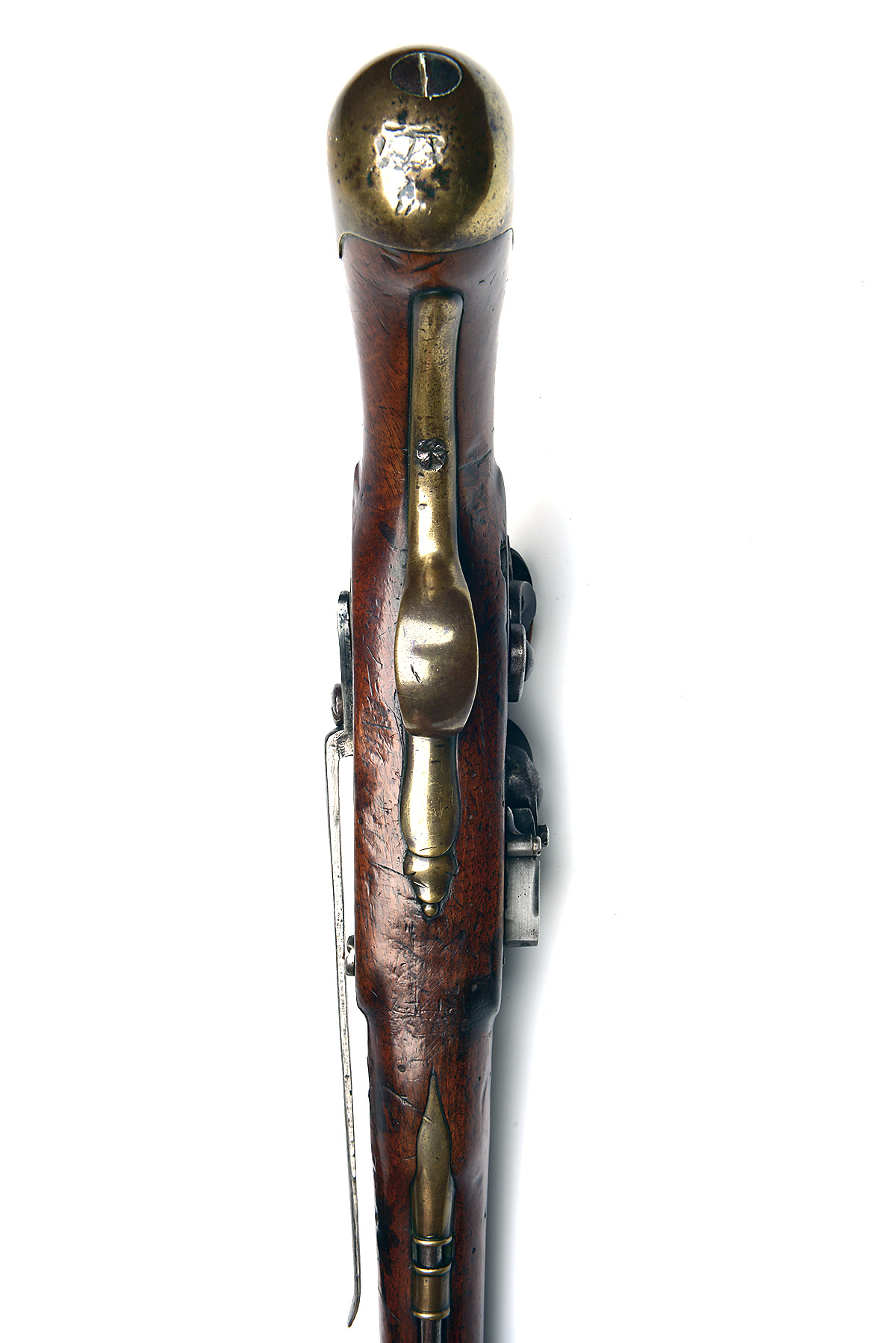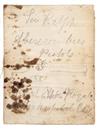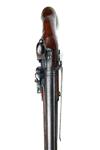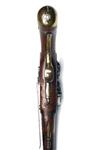[clock129770]
Product Details
A .600 FLINTLOCK SERVICE-PISTOL, SIGNATURE ERASED, MODEL 'SEA-SERVICE', no visible serial number,
circa 1800, the barrel shortened by regulation to 9in., Tower proofs, solid top-tang, borderline engraved lock, the Tower signature erased from the tail and the GR crown device partially erased from in front of the hammer, walnut full-stock, carved apron around the top-tang, heavy brass furniture except iron belt hook and under-barrel ramrod, some shallow pitting and a small loss to wood below tail of lock
Other Notes: This pistol was found with an old note stored inside the barrel (now framed and accompanying the lot) stating that this pistol was the property of Sir Ralph Abercrombie together with a line drawing of a blunderbuss and other indecipherable writing. It is unlikely to refer to this pistol as Sir Ralph Abercrombie died in 1801, before this pistol would probably have been modified, although the shortening of Sea Service pistols was not unheard of before this date and the pistol is in period with his career.
Ralph Abercomby (often spelt 'Abercrombie') was the eldest son of George Abercromby of Tullibody, Clackmannanshire, and a brother of the advocate Alexander Abercromby, Lord Abercromby and General Sir Robert Abercromby. He was born at Menstrie Castle, Clackmannanshire. His mother was the clever and beautiful daughter of Mr. Dundas of Manor in Stirlingshire.
Ralph Abercromby's education, begun by a private tutor, was continued at the school of Mr. Moir at Alloa, then considered one of the best in Scotland despite its Jacobite leanings. After passing some time here, Ralph was sent to Rugby, where he remained till he was eighteen, then becoming a student at the University of Edinburgh. In Edinburgh he studied moral and natural philosophy and civil law and was regarded by his professors as sound rather than brilliant. He was sent to Leipzig University in 1754 to study civil law with a view to career as an advocate.
On returning from the continent, Abercromby expressed a strong preference for the military profession, and a cornet's commission was accordingly obtained for him (March 1756) in the 3rd Dragoon Guards. He served with his regiment in the Seven Years' War, and thus, the opportunity afforded him of studying the methods of Frederick the Great, who moulded his military character and formed his tactical ideas. He rose through the intermediate grades to the rank of Lieutenant-Colonel of the regiment (1773) and Brevet Colonel in 1780, then in 1781, he became Colonel of the King's Irish Infantry. When that regiment was disbanded in 1783, he retired upon half pay. He also entered Parliament as MP for Clackmannanshire (1774–1780). He was a strong supporter of the American cause in the American Revolutionary War, and remained in Ireland to avoid having to fight against the colonists.
When France declared war against Great Britain in 1793, he resumed his duties. He was appointed command of a brigade under the Duke of York for service in the Netherlands, where he commanded the advanced guard in the action at Le Cateau. During the 1794 withdrawal to Holland, he commanded the allied forces in the action at Boxtel and was wounded directing operations at Fort St Andries on the Waal. In 1795, he was appointed a Knight of the Bath for his services. That same year, he was appointed to succeed Sir Charles Grey as commander-in-chief of the British forces in the West Indies. In 1796, Grenada was suddenly attacked and taken by a detachment of the army under his orders. Afterwards, Abercromby secured possession of the settlements of Demerara and Essequibo in South America, the islands of Saint Lucia, Saint Vincent and Trinidad. A major assault on the port of San Juan, Puerto Rico, in April 1797 ended in disaster after fierce fighting where both sides suffered heavy losses.
Abercromby returned to Europe and, in reward for his services, was appointed Colonel of the 2nd (Royal North British) Regiment of Dragoons. He was also made Lieutenant-Governor of the Isle of Wight, Governor of Fort George and Fort Augustus in the Scottish Highlands, and promoted to the rank of Lieutenant-General. He again entered Parliament as member for Clackmannanshire from 1796 to 1798. From 1797 to 1798, he was Commander-in-Chief of the forces in Ireland. To quote the biographic entry in the 1888 Encyclopædia Britannica: "There he laboured to maintain the discipline of the army, to suppress the rising rebellion, and to protect the people from military oppression, with the care worthy of a great General and an enlightened and beneficent statesman. When he was appointed to the command in Ireland, an invasion of that country by the French was confidently anticipated by the British Government. He used his utmost efforts to restore the discipline of an army that was utterly disorganized; and, as a first step, he anxiously endeavoured to protect the people by re-establishing the supremacy of the civil power, and not allowing the military to be called out, except when it was indispensably necessary for the enforcement of the law and the maintenance of order." Finding that he received no adequate support from the head of the Irish Government, and that all his efforts were opposed and thwarted by those who presided in the councils of Ireland, he resigned the command. His departure from Ireland was deeply lamented by the reflecting portion of the people, and was speedily followed by those disastrous results which he had anticipated, and which he so ardently desired and had so wisely endeavoured to prevent.
After holding for a short period the office of Commander-in-Chief in Scotland, Sir Ralph, when the enterprise against the Dutch Batavian Republic was resolved upon in 1799, was again called to command under the Duke of York. The campaign of 1799 ended in disaster, but friend and foe alike confessed that the most decisive victory could not have more conspicuously proved the talents of this distinguished officer. In 1800, he was sent with an army to recover Egypt from France. His experience in the Netherlands and the West Indies particularly fitted him for this new command, as was proved when he carried his army in health, in spirits, and with the requisite supplies to the destined scene of action despite great difficulties. The debarkation of the troops at Abukir, in the face of strenuous opposition, is justly ranked among the most daring and brilliant exploits of the British army.
In the same year he commanded the expedition to the Mediterranean, and after some brilliant operations defeated the French in the Battle of Alexandria, March 21, 1801. During the action he was struck by a musket-ball in the thigh; but not until the battle was won and he saw the enemy retreating did he show any sign of pain. He was borne from the field in a hammock, cheered by the blessings of the soldiers as he passed, and conveyed on board the flag-ship HMS Foudroyant which was moored in the harbour. The ball could not be extracted; mortification ensued, and seven days later, on March 28, 1801, he died. His old friend and commander, the Duke of York, paid tribute to Abercromby's memory in general orders: "His steady observance of discipline, his ever-watchful attention to the health and wants of his troops, the persevering and unconquerable spirit which marked his military career, the splendour of his actions in the field and the heroism of his death, are worthy the imitation of all who desire, like him, a life of heroism and a death of glory." He was buried on St. John's Bastion within Fort Saint Elmo in Valletta, Malta. The British military renamed it Abercrombie's Bastion in his honour. The adjacent curtain wall linking this bastion to the fortifications of Valletta, originally called Santa Ubaldesca Curtain, was also renamed Abercrombie's Curtain in his honour. By a vote of the House of Commons, a monument to him was erected in St Paul's Cathedral in Abercromby Square, Liverpool. His widow was created Baroness Abercromby of Tullibody and Aboukir Bay, and a pension of £2,000 a year was settled on her and her two successors in the title.
Please click HERE to view Terms & Conditions.
Estimate £1,200-1,500










